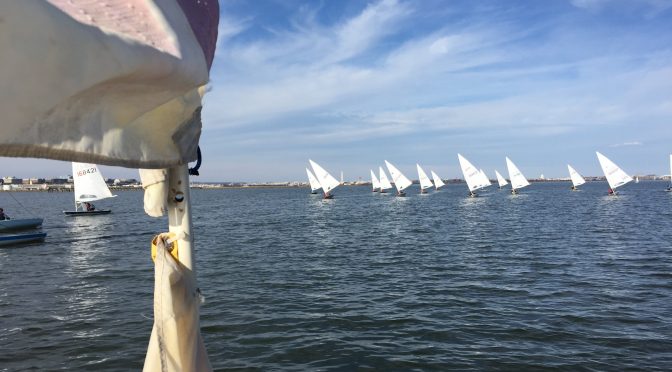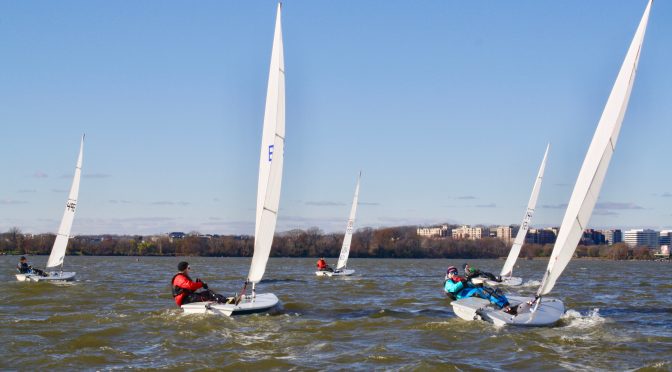Sunday was sunny, warmish, and probably the windiest frostbite day so far. John and Greg laid out an Olympic triangle course, which provided for planing when the gusts coincided with the reach legs. Greg and John heroically tried to adjust the course to the changing winds and were, on average, successful. Big thanks to John and Greg for RCing and to Farley for the attached results.
The starts were exciting – it was often possible to sail the length of the line in less than 20 seconds, so it quickly got crowded. I preferred shuttling between the pin and the boat and coming on port to find a good spot behind the RC boat about 35 seconds before the start. That way I avoided getting stuck in a crowd … it worked sometimes. Having, for once, the current largely in the same direction as the wind also made the typical strategy of lingering on the line viable.
On the upwind leg, gusts often came along with 30-40 degree wind shifts. That meant we had to be on our toes … or more literally ready to quickly adjust the sheet, rudder, and body position. The first victim I witnessed was Jim G., who had to tack as Farley came on starboard right at the time of a big gust and wind shift, which landed Jim with a taste of the Potomac.
Downwind was fun as there was just enough wind for a bit of waves to form. That allowed for practicing both following the waves and using body movement and sheeting to control the boat with minimal rudder. Supposedly s-turns on the downwind leg are more efficient, but I still haven’t figured them out. During stronger gusts, the jibing could also get exciting. At one point I was chasing Len for the first place he capsized right by the mark. I then managed to not only also capsize, but as I tried to climb around to the daggerboard I somehow tripped in a way that had me drop backward in the water hitting daggerboard on the way down before having my first taste of the Potomac. A far cry from the salty sea water I grew up with, but not as bad as feared. Glorious as my fail felt, had we had a weekly epic performance award, it would have probably gone to Tyler, who artfully lodged 8603 almost completely atop Celeste’s laser. Surely I missed many other exciting incidents – all in all, another beautiful Sunday on the Potomac.
Now, this is my 3rd 3rd place write-up, so I’d suggest we adjust to formula next season to include more authors. Not just because I’m lazy, but also for literary diversity and because I’m curious about others’ experiences and ideas.
Finally, happy International Women’s Day – it is truly a joy to have you dedicated, fearless, fun, and lovely women both on the water and on the dock – you represent the best of what IWD stands for!


